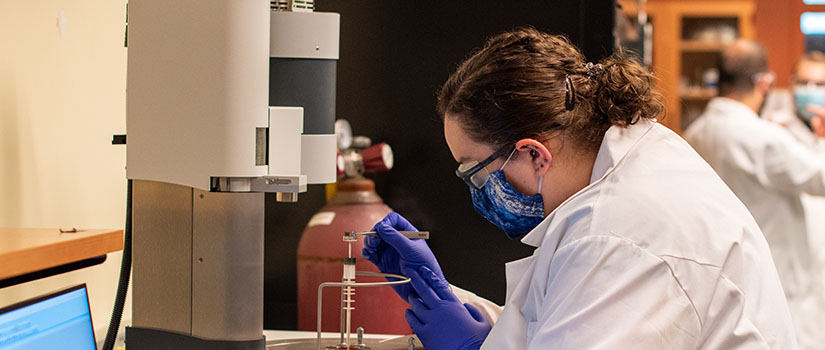In 2002, South Carolina started the SmartState Program to help create a knowledge-based economy. Twelve years later, the legislature added to that economy when it voted to establish the General Atomics SmartState Center for Transformational Nuclear Technologies at the University of South Carolina in 2014. The center was made possible, in part, through a $900,000 gift from San Diego-based General Atomics, a leading nuclear technology company.
Once created, Nuclear Engineering Program Director and current Mechanical Engineering Chair Travis Knight knew he needed a strong leader with extensive experience in nuclear fuels to lead the center. He contacted Ted Besmann, who at the time was preparing to leave his position at the Oak Ridge National Laboratory in Tennessee. Besmann, now a professor in the Department of Mechanical Engineering, gladly accepted.
“For most of my 39 years at Oak Ridge I was a group leader. I oversaw a group while doing my own personal research, including work on nuclear fuels and nuclear waste forms. The center is a reasonable continuation of those efforts,” Besmann says.
The center's four main areas of research include nuclear fuel analysis and development, nuclear material modeling and simulation, nuclear waste forms, and public policy. Its goals are to meet future energy needs and promote clean and safe nuclear energy.
Some of the group’s research has focused on accident-tolerant fuels, which are intended to be more resistant to nuclear accidents and the type of damage that occurred at Japan’s Fukushima nuclear plant following the 2011 earthquake and tsunami. The Department of Energy (DOE) started an accident-tolerant fuel program, which Besmann had previously worked on at Oak Ridge National Laboratory after the incident.
“In the case of the Fukushima accident, as temperatures rose in the reactor, chemical reactions really took off and caused more damage,” Besmann says. “The idea was to see if we could mitigate [chemical reactions] to buy more time and cause less damage. I talked to the DOE about continuing some activity here and received money to get that started.”
In 2016, Besmann secured funding for a three-year research project to study uranium silicide fuels, an inorganic compound of uranium, and their basic chemistry and behavior with cladding, the thin-walled metal tube that forms the outer cover of a nuclear fuel rod to protect the nuclear fuel.
“Our research was experimental and computational to understand how uranium silicide interacts with potential cladding materials. The view was that these fuels would not use conventional cladding, which was problematic at Fukushima,” Besmann says. “We determined that as expected, some of the options could effectively be used as an accident-tolerant fuel system.”
In 2017, the DOE asked Besmann and the center to begin working on a database for molten salt that could theoretically be used in a reactor. Molten salt reactors operate at normal atmospheric pressure, instead of the enormous pressure needed for a typical light-water reactor. It provides a significant safety advantage since it eliminates the need for large, heavy and expensive containment structures.
“In most cases, the fuels used are salt, such as sodium chloride mixed with potassium chloride that also contain uranium chloride. The U.S. built a small molten salt reactor at Oak Ridge in the late 1960s to demonstrate its feasibility, which was extremely successful. But the Atomic Energy Commission at the time decided not to do future work on the concept,” Besmann says.
The molten salt technology was dormant until several small companies were established a few years ago with the belief that relatively small molten salt reactors could be built and sold to utilities as an alternative to large power plants. The increased interest sparked the need to closely understand salt chemistry, and a demand for a database of its properties. Last year, Besmann was awarded a three-year, $600,000 grant from the DOE to add to the database, with an emphasis on chemical components relevant to corrosion.
“These companies began developing the technology, and the DOE leapt in with a program to do the base technology and cover all the bases. I was asked to develop a database on the chemistry and have been working on it with my group,” Besmann says. “It’s difficult work to create fundamental systems and build up more complex systems. The database will have all the systems and be useable with computer codes. It’s been available, but we keep adding more components since there is a lot of interest.”
Nuclear engineering Ph.D. student Jacob Yingling is one of several graduate students to work with Besmann over the last seven years. He is impressed by the ambition of the center’s projects and impact of its achievements.
“For example, the work we do supports the nation's energy economy by providing experimental measurements and computational models that are fundamental to the success of molten salt reactor technologies. This information is used by national laboratories and private industry to further the nation's clean energy goals,” Yingling says.
Going forward, Besmann would like the General Atomics Center to establish a foothold on new concepts for nuclear fuels and waste forms. To a large extent, the center is supporting the work of those in this area since they are completing computational work. But the center has other ideas that could also have merit.
“There are novel fuel concepts we would like to help develop that are being considered by NASA for nuclear rockets. These are ideas first tried out in the 1960s and now are seeing renewed effort as we look to manned missions to Mars,” Besmann says. “For nuclear waste materials, it would be good to take the basic knowledge we have created to the next level; to begin to design waste forms that can improve safety and efficiency.”
